HP Veer 4G Review - Getting Us Excited for Pre 3
by Brian Klug on June 7, 2011 5:01 PM EST- Posted in
- Smartphones
- HP
- AT&T
- Palm
- veer
- webOS
- HSPA+
- Mobile
- HP Veer 4G
I suppose now is as good a time as any to go into the cellular connectivity situation on the Veer. There was some confusion initially about whether the Veer “4G” truly had HSPA+ or not, and a number of incorrect assertions came up surrounding whether HSDPA 21.1 (and thus 64QAM) support is required for a device to be considered actually HSPA+. I went into this in my earlier this just in post when talking about the Veer 4G and encourage you to read it, but wanted to go in a bit more depth with explanations now.
Before I go any further, let’s discuss modulation. Modulation is the act of physically encoding data on a signal, or in this case an electromagnetic wave. The simplest example of modulation is On Off Keying (OOK) or Amplitude Shift Keying (ASK). With OOK, you can imagine no light at all being coded to a binary 0, and the presence of light being coded to a binary 1. Then, with the simple act of blocking the light (either with a chopper, or your hand, or by turning the source on or off) you can encode that binary 0 or 1. It turns out that just turning a source on and off (and only using two states) isn’t a very spectrally efficient means of encoding data. But there are other ways of encoding data. Regardless, amplitude is one parameter we can vary.
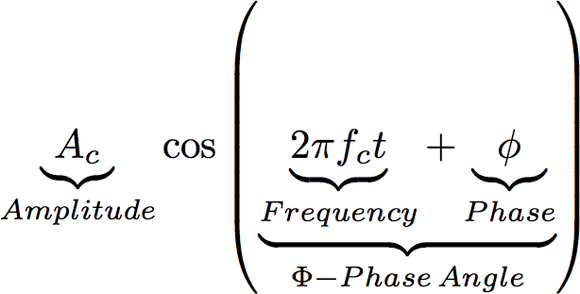
The next is the frequency of the electromagnetic wave. To explain this we need to first realize that a wave can be described with a cosine. Looking at the equation shows us almost everything we can modify or modulate with respect to the signal, with the exception of one more parameter - polarization. Those three are amplitude, frequency, and phase. Everything inside the cosine’s parameter together serves to describe the wave’s phase angle. Obviously the next possible thing to modulate is this phase angle – we could code a phase of 0 to a binary 0, and phase of π (180 degrees) to a binary 1. This is called Binary Phase Shift Keying (BPSK). You can imagine using more positions along the phase to encode more data – just go up a power of 2 and encode a phase of 0 to binary 00, phase of π/2 to 01, π to 11, and 3/2π to 10. Often this is shifted by π/4, but in either configuration with 4 points you get to Quadrature Phase Shift Keying (QPSK).
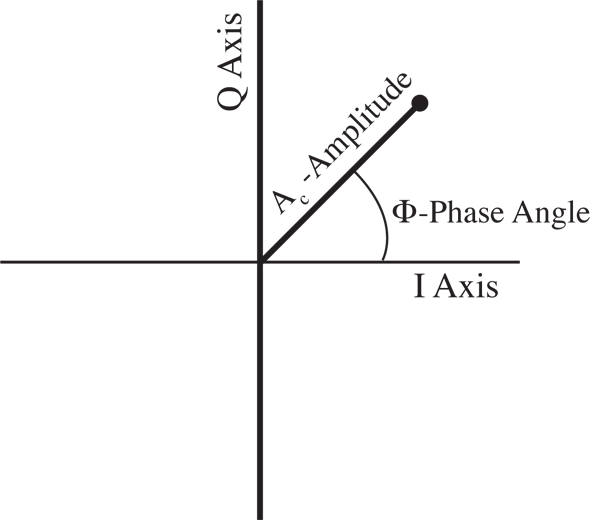
This can be visualized in polar coordinates, where the amplitude is the distance from the origin to a point, and the phase angle is simply the angle from the x-axis to the point. Now the term phase angle makes sense. A plot very similar to this is called an I/Q plot, with I standing for in-phase, and Q for quadrature (90-degrees out of phase). This is essentially a polar plot, but with the names for the two orthogonal components just labeled I and Q due to their common use in an IQ modulator.
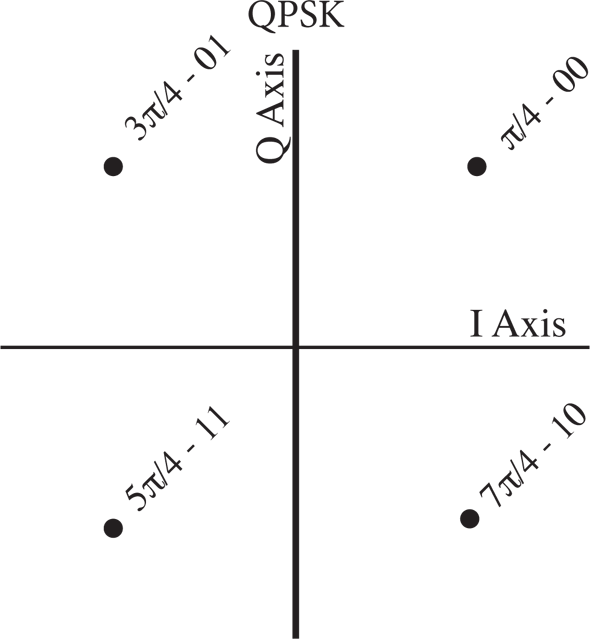
It doesn’t take much imagination to see how you can modulate amplitude alongside phase and get even more points to encode to binary data. This is called Quadrature Amplitude Modulation (QAM) and essentially is the combination of both ASK and PSK. If you divide the I/Q plot into regions, each can then correspond to some predefined coding. The encoder and decoder share this mapping, and we can transact data based on a specific value of the amplitude and phase angle.
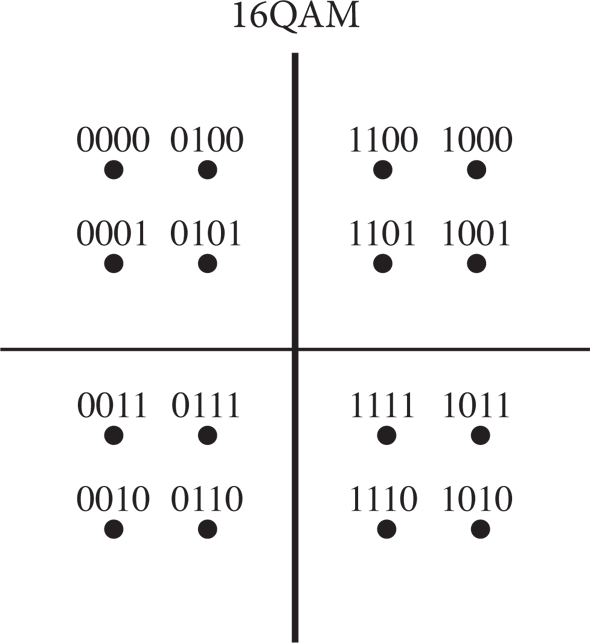
Things go by powers of two here so we can add one more digit of coding – thus 16QAM lets us code four binary digits, and 64QAM lets us code six. These different codings are simply different higher powers of QAM, and sometimes you’ll just hear them referred to as higher order modulation schemes. All we’re doing is increasing the power of two and dividing the IQ plot into more points. Plotted on the I/Q plot, these points form what’s called a constellation map.
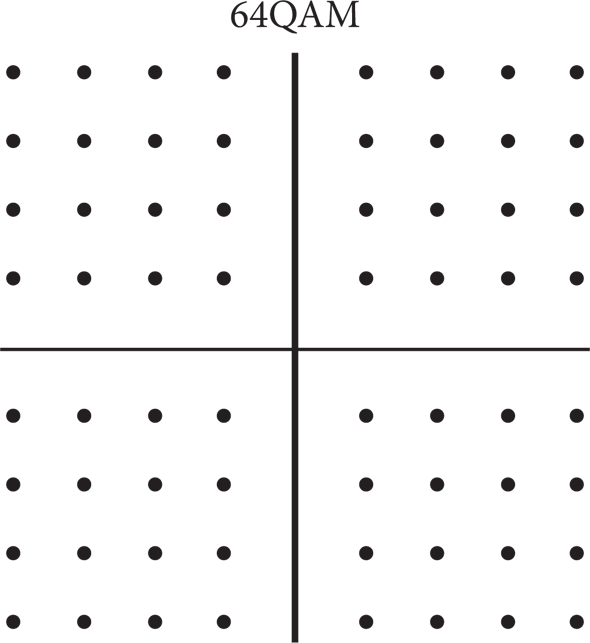
I'm not even going to bother labeling the codings on this one...
There is a tradeoff, however. Moving to more and more decision points results in a densely packed constellation, with correspondingly less space between each point. We can’t get any more area, since we’re encoding between an amplitude of 0 and 1, and phase angle of 0 and 2π. As a result, sensitivity to noise and interference goes up, as tolerances (the area between points) shrinks. On the demodulator, there’s a component called the decision circuit whose job it is to decide what coding each point should correspond to. It does its job simply by looking at where points land and how close they are to a symbol. There are ways of improving the decision circuit, but there’s no getting around the fact that each power of two makes the decision circuit’s job harder.










25 Comments
View All Comments
ClockerXP - Saturday, June 11, 2011 - link
Dial ##3-836# to get to the menu where you can disable 3G. Works on my Pre+ on Verizon!ClockerXP - Saturday, June 11, 2011 - link
I mean ##3836# (no dash)dananski - Sunday, June 12, 2011 - link
I agree that the hardware is better than people say. I haven't had any problems with mine and it only has minor scratches from all the times I've dropped it. But the OS is good too. Cards and synergy are two things I couldn't go without, and I like the simple gestures.ioannis - Tuesday, June 7, 2011 - link
Brian, thanks for the comprehensive review, delivered in the usual Anandtech quality.The App Catalogue compatibility seems to be the only major complain I'd have over this phone. My question is, will WebOS 3.0 with the Enyo framework come to the Veer? And assuming that all the apps eventually get ported to it (or at least all apps released from the time 3.0 is out will be based on it), would that solve the 'pixel density'/resolution-dependent apps problem?
softdrinkviking - Tuesday, June 7, 2011 - link
Hi Brian. Great review. I especially liked your explanation of HSPA+, nice work there.I had one question. You again referred to Super LCD as (IPS) in this article, as you did in the article a few days ago (HTC evo 3D). In that article you crossed out the (IPS) and I assumed that meant you were reassessing that. Have you come to any conclusions about Super LCD and what process it is made with?
Brian Klug - Tuesday, June 7, 2011 - link
So I was mistaken earlier about Super LCD being IPS, I went over my notes and have written down that Super LCD is just PVA. I'm going to try and do some more digging to find out why I have that here and what the implications are. Honestly though the SLCD display on the Sensation looks quite good.-Brian
Solidstate89 - Tuesday, June 7, 2011 - link
I haven't owned a WebOS phone because of the flakiness of the hardware, but the OS has always appealed to me. Similarly although the Veer isn't for me, I do like just how much better WebOS 2.0 is looking.I sincerely wish them the best in the market as it is quite simply a brilliantly designed OS. However it's just taken too long to get to market. I wanted to get a Pre 3 on Verizon, but realized it would be too late with Verizon Wireless nixing its Unlimited Data plans before it could be released so I went to sprint and picked up a WP7 device.
Quite happy with it, and although it's a blatant rip-off, I can't wait for the card-style multitasking to arrive with the Mango Update :)
Best of luck to WebOS.
softdrinkviking - Tuesday, June 7, 2011 - link
cool, thanks for the reply & info. i have seen plenty of PVA screens in the store and they look pretty good to me, maybe not as good as the high-end NECs and other professional monitors, but i had a hard time telling the difference between the led backlit LG IPS and the similar sized BenQ with a PVA. (this is in Japan, so i can't say what models you have in the states).As long as they are good quality, and a decent resolution, I can't imagine that PVA would be unacceptable on a cel phone. they are undoubtedly better than TN.
jamawass - Wednesday, June 8, 2011 - link
I think the veer makes sense if you take into consideration hp's tablet strategy. A veer with mobile hotspot would be an excellent combo with a 7 in touchpad ( to be released after the 10 in later this yr). I have a 7 in sony reader which fits in all my jacket's pockets. That's my device of choice when I'm waiting at the auto shop, etc and I always receives glances when I whip it out of my jacket. It's light, and much more portable than an ipad.I suspect this is one of hp's strategies with the veer and I wouldn't be surprised if they market them as a combo deal in the future.
I've used webos for a year now and generally like it's efficiency, but Apple and other companies have been cannibalising their innovations. As stated above, hp needs to accelerate the upgrade cycle in both soft and hardware to survive.
marc1000 - Wednesday, June 8, 2011 - link
Brian and Anand, I could not find a way to contact you. So I will write this down on the comment section.Microsoft is killing the only thing cool on all older WindowsMobile phones (6.5 & below): the MyPhone service will die in a couple months.
please read this thread at XDA where some users reported receiving the same MS email with the news.
http://forum.xda-developers.com/showthread.php?t=1...